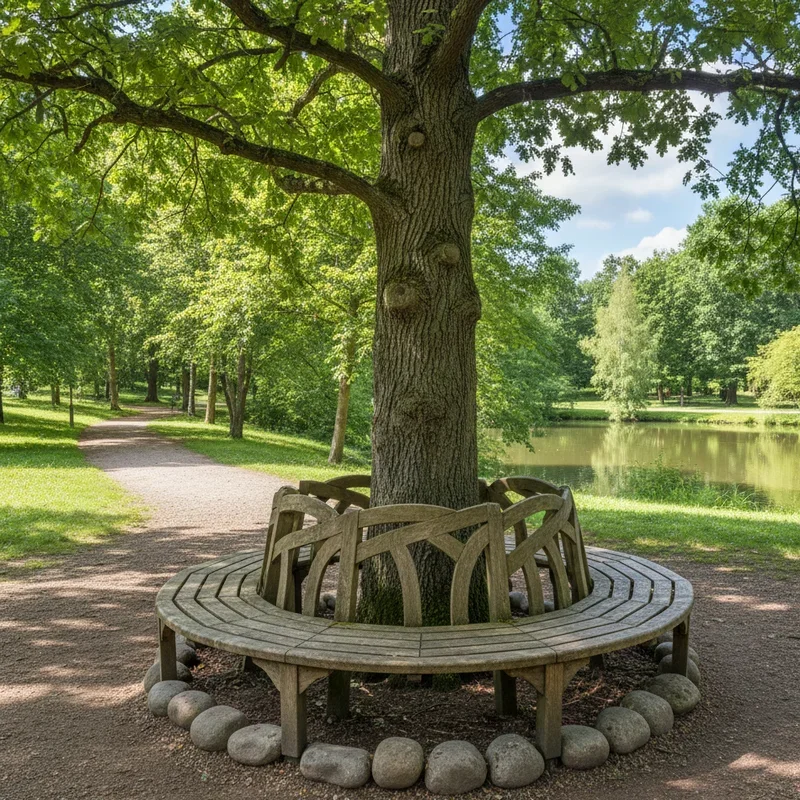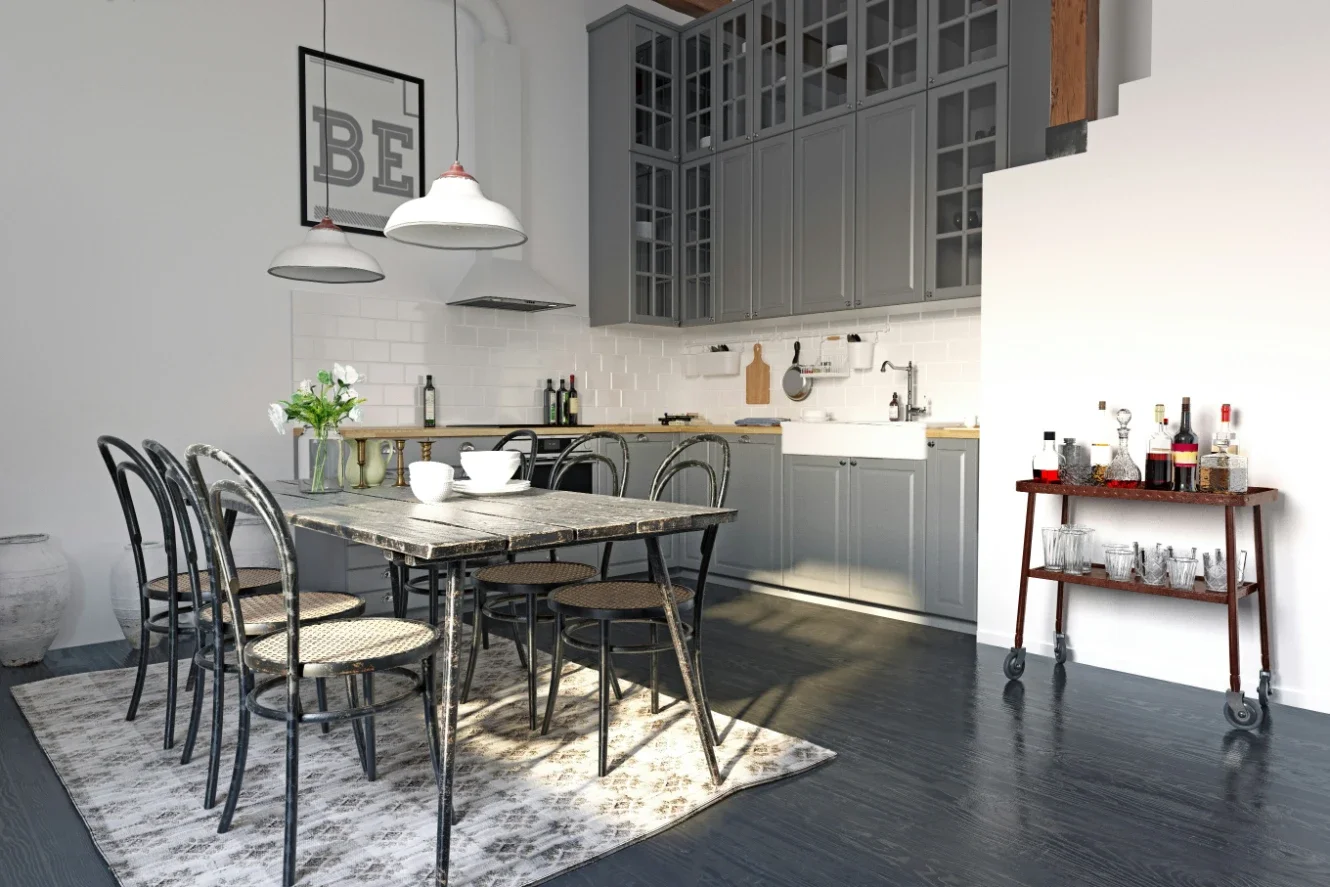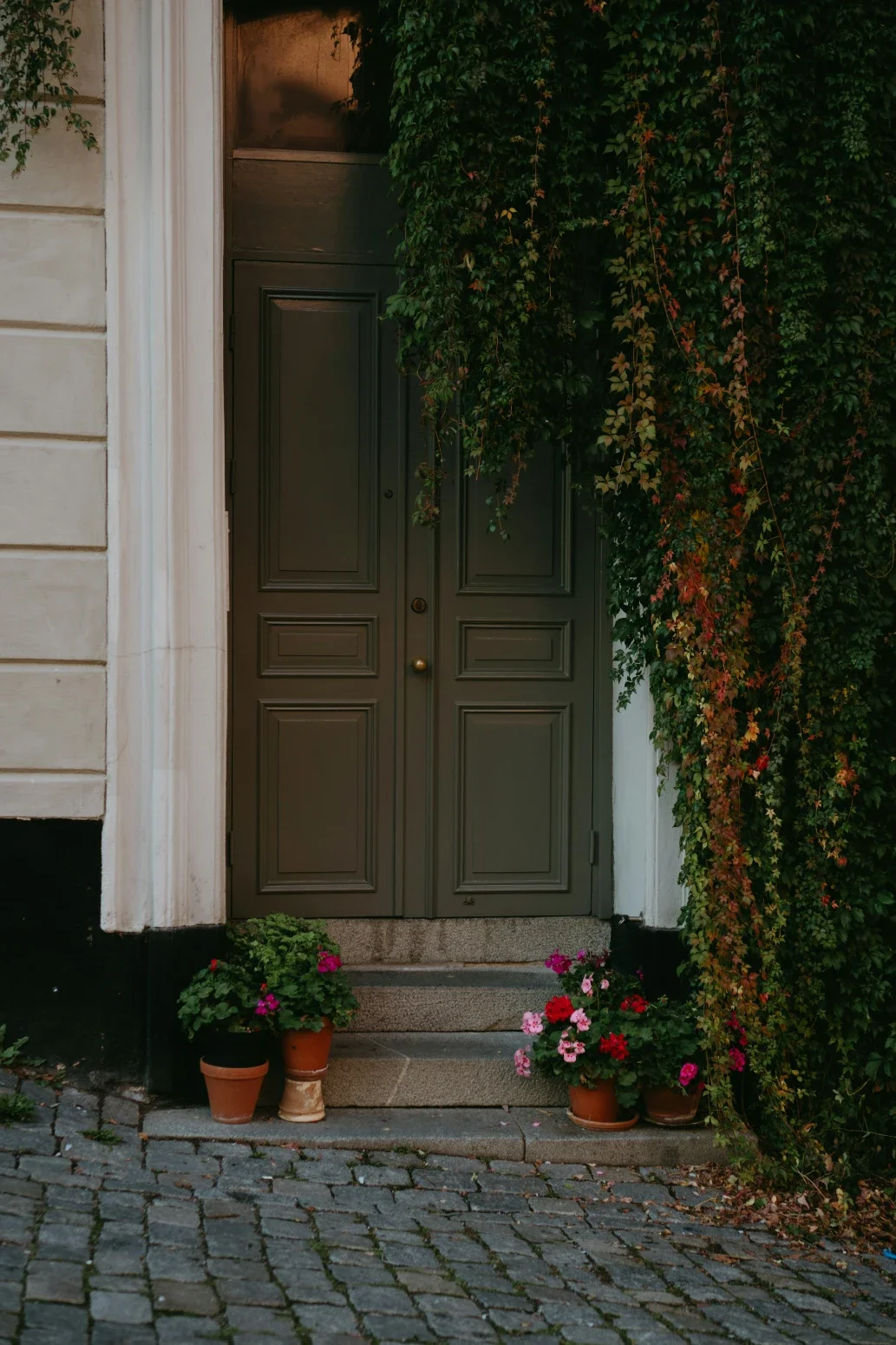15 Tree Bench Ideas to Elevate Your Garden
Discover 15 stunning tree bench ideas that transform your garden into a peaceful retreat with style, comfort, and natural beauty.
Have you ever dreamed of having that perfect spot in your garden where you can sip your morning coffee while birds sing overhead? A tree bench might be exactly what your outdoor space needs. These charming additions combine the timeless beauty of nature with practical seating, creating intimate gathering spots that invite conversation, reflection, and relaxation. Picture yourself nestled under a canopy of leaves, feeling the cool breeze on a hot summer day while reading your favorite book. Tree benches aren't just furniture; they're experiences waiting to happen. They transform ordinary trees into focal points that anchor your garden design while providing functional spaces for rest and contemplation. Whether you have a sprawling backyard with mature oaks or a modest garden with a single apple tree, there's a tree bench solution that will work perfectly for your space. From classic circular designs that embrace the trunk to modern asymmetrical creations that challenge convention, these 15 ideas will inspire you to create your own garden sanctuary. Ready to discover how a simple bench can completely transform your relationship with your outdoor space? Let's explore these creative possibilities together.
1. Classic Circular Tree Bench
The circular tree bench remains the most iconic and timeless design for a reason. This complete ring surrounds your tree trunk, creating a 360-degree seating area that encourages social interaction from all angles. Friends and family can gather around, facing each other naturally without anyone feeling excluded or sitting in an awkward position. The circular design works beautifully with mature trees that have substantial trunks and spreading canopies providing ample shade. Choose materials like cedar, teak, or treated pine that withstand weather conditions while aging gracefully. The continuous seating surface creates visual harmony and balance in your garden, making the tree itself the undisputed star of the show. Consider adding cushions in weather-resistant fabrics for extra comfort during extended conversations or peaceful afternoon naps under rustling leaves.
2. Half-Circle Tree Bench Design
When space is limited or your tree sits near a property boundary, a half-circle bench offers the perfect compromise between style and practicality. This design provides generous seating while leaving the back side open for maintenance access or to prevent crowding against fences and walls. The semicircular shape still creates an intimate gathering spot that capitalizes on your tree's shade without requiring a full commitment of space. This style works exceptionally well for trees positioned near patios, decks, or walkways where you want seating but need to maintain clear pathways. The open back also makes it easier to mulch around the tree base and monitor root health. Paint your half-circle bench in colors that complement your home's exterior or garden theme, from classic white to bold blues or natural wood stains.
3. Built-In Planter Box Bench
Why settle for just a bench when you can combine seating with gardening opportunities? A tree bench with integrated planter boxes creates a lush, multi-dimensional feature that elevates your garden's visual appeal dramatically. Build raised boxes around the bench's perimeter and fill them with colorful annuals, cascading flowers, or fragrant herbs that release delightful scents when brushed against. This design transforms your seating area into a living gallery that changes with the seasons, offering fresh blooms in spring, vibrant colors in summer, and interesting textures in fall. The planters also define the seating space, creating a natural boundary that feels intentional rather than restrictive. Choose flowers that attract butterflies and hummingbirds to add movement and life to your peaceful retreat. This combination approach maximizes every square inch of your garden real estate.
4. Rustic Log Tree Bench
Embrace natural aesthetics with a bench crafted from split logs or rough-hewn timber that celebrates wood's organic beauty. This approach suits cottage gardens, woodland settings, or rustic landscapes where authenticity matters more than polished perfection. Use logs with bark still attached for maximum character, or smooth them slightly for comfort while maintaining their rugged appearance. The irregular shapes and natural imperfections tell a story, making each bench truly one-of-a-kind. Position log sections at varying heights around your tree to create casual, informal seating that invites relaxation without fussiness. This style particularly shines under fruit trees or in wildflower gardens where the goal is harmonizing with nature rather than controlling it. Seal the wood to extend its lifespan while preserving its weathered, timeworn character that improves with age.
5. Modern Geometric Tree Bench
Break away from traditional curves with angular, geometric designs that make bold contemporary statements in modern gardens. Square or rectangular sections arranged around your tree create striking visual contrast between the organic tree trunk and crisp, clean lines. This approach appeals to minimalist sensibilities and works brilliantly in urban gardens or alongside modern architecture where cohesive design language matters. Choose materials like composite decking, powder-coated metal, or smooth concrete that emphasize sleek sophistication. The geometric approach allows for creative configurations, stacking levels, or creating asymmetrical arrangements that challenge expectations while remaining functional. Paint in monochromatic schemes or use natural materials in unexpected ways. This style proves that tree benches can be contemporary art pieces that respect nature while celebrating human creativity and innovation.
6. Swing Bench Hanging from Branches
Transform your tree into an adult playground by suspending a swing bench from sturdy overhead branches. This nostalgic approach brings childlike joy to garden relaxation while providing gentle motion that soothes stress and encourages daydreaming. Choose a comfortable two-seater swing with supportive backs and armrests, ensuring it can safely hold multiple adults. Install using heavy-duty chains or marine-grade rope rated for well beyond your expected weight capacity. The swinging motion creates a dynamic element in your garden, drawing attention and inviting interaction in ways static benches cannot. Position it to face your best garden views or toward your home for supervision of playing children. Add weather-resistant cushions in cheerful patterns that reflect your personality. This playful option reminds us that gardens should spark joy and reconnect us with simpler pleasures.
7. Hexagonal Tree Surround Bench
The hexagonal design offers a sophisticated middle ground between circular and square benches, providing excellent seating capacity with distinctive geometric appeal. Six equal sides create a balanced, symmetrical look that feels both organized and organic simultaneously. This shape distributes seating evenly around the tree while the angled sides add visual interest that catches the eye from multiple viewpoints. The hexagon's geometry makes construction more straightforward than circles for DIY enthusiasts while still creating that wraparound effect. Each flat section can be built separately and assembled on-site, making this an accessible weekend project. The angles also create natural conversation groupings, as people sitting on adjacent sides can easily interact. Choose contrasting wood stains for alternating panels to emphasize the geometric pattern or keep everything uniform for understated elegance.
8. Backless Minimalist Tree Bench
Sometimes simplicity speaks loudest. A backless bench wrapping around your tree offers clean, unobtrusive seating that lets the tree remain the focal point without competition. This stripped-down approach works beautifully in small gardens where visual clutter needs minimizing or in formal landscapes where restraint equals elegance. The absence of backs makes the bench accessible from all sides, encouraging spontaneous seating without predetermined front or back orientations. This design also costs less and requires fewer materials, making it budget-friendly for DIY builders. The low profile prevents the bench from blocking garden views or creating visual barriers that divide spaces. Consider wider seat depths to compensate for the lack of back support, allowing people to sit comfortably facing any direction. Add removable cushions when extra comfort is needed without permanent commitment.
9. Corner L-Shaped Tree Bench
When your tree grows in a corner of your property or garden bed, an L-shaped bench maximizes seating while respecting spatial constraints. This practical design provides generous seating along two sides while leaving the remaining space open for access and maintenance. The perpendicular configuration creates natural conversation areas where people can sit facing each other at right angles, making it perfect for intimate chats or morning coffee with a friend. This shape also defines outdoor rooms within larger gardens, using the bench and tree combination to create distinct zones for different activities. The corner placement often provides additional privacy by positioning seating away from main sightlines. Build with backs on one or both sides depending on your needs, or keep it backless for maximum flexibility and openness.
10. Multi-Tiered Platform Bench
Create dramatic visual impact by building multiple levels around your tree, combining seating with stepped platforms that add architectural interest to flat landscapes. This approach works spectacularly well on sloped terrain where different levels naturally follow the land's contours. The varying heights provide diverse seating options, perching spots for placing drinks or books, and display areas for potted plants or decorative objects. Children love exploring different levels, making this design family-friendly and engaging for all ages. The tiered structure also accommodates trees with complex root systems by allowing platforms to step up or down as needed without disturbing roots. Use contrasting materials for different levels to emphasize the dimensional effect, perhaps combining wood seats with stone platforms. This multifunctional design transforms simple seating into a garden feature that commands attention and admiration.
11. Curved Contour Hugging Bench
Rather than forcing geometric shapes around your tree, consider a custom curved bench that follows the trunk's unique contours organically. This bespoke approach celebrates your specific tree's character, creating a bench that fits like it grew there naturally. The gentle curves create flowing lines that guide the eye smoothly around the space while providing ergonomic seating that conforms to the body's natural shape. This design requires more planning and potentially professional construction, but the result is a truly unique garden feature that cannot be replicated elsewhere. The continuous curve eliminates sharp corners, making it safer for children and creating a softer, more inviting appearance. Consider adding a subtle back that follows the same flowing lines for additional comfort without disrupting the organic aesthetic.
12. Vintage Wrought Iron Tree Bench
Bring old-world elegance to your garden with a decorative wrought iron bench featuring intricate scrollwork, classic patterns, or Victorian-inspired details. These ornate designs add romantic charm and timeless sophistication that elevates any garden into something extraordinary. The metal's durability ensures decades of service while developing a beautiful patina that adds character over time. Wrought iron works beautifully in formal gardens, rose gardens, or heritage properties where traditional aesthetics are celebrated. The openwork designs allow air circulation and prevent water pooling that damages solid wood benches. Paint in classic black, heritage green, or even unexpected colors like deep burgundy for dramatic effect. Add plush cushions to soften the metal's hardness and create a comfortable retreat that combines historical beauty with modern comfort. This style proves that function and artistry can coexist beautifully.
13. DIY Pallet Tree Bench
Budget-conscious gardeners can create stunning tree benches using reclaimed wooden pallets, proving that beautiful outdoor spaces don't require expensive investments. Pallets offer pre-assembled slats that simplify construction while their weathered appearance adds instant rustic charm. Sand rough edges smooth, treat wood to prevent rot, and arrange pallets in configurations that suit your tree's size and shape. This approach embraces sustainability by repurposing materials destined for landfills while creating functional garden furniture. The pallet's modular nature allows easy customization, stacking for height, or reconfiguring as needs change. Stain or paint to match your garden's color scheme, or leave natural for authentic industrial-chic appeal. Add cushions made from outdoor fabric remnants to complete your budget-friendly creation. This DIY option empowers you to create personalized garden features regardless of financial constraints.
14. Stone and Wood Combination Bench
Marry the permanence of stone with wood's warmth by creating a hybrid bench that balances durability with comfort. Use stacked stone, concrete blocks, or natural boulders for the base structure, then add wooden seating surfaces that provide comfortable sitting spots. This combination offers the best of both materials: stone's longevity and low maintenance paired with wood's natural beauty and tactile warmth. The substantial stone base grounds the bench visually, making it feel like a permanent garden feature rather than temporary furniture. This approach works particularly well in Mediterranean, contemporary, or naturalistic garden styles where mixed materials create textural interest. The stone foundation also elevates wood off the ground, preventing moisture damage and extending its lifespan significantly. Consider incorporating stone planters into the design or adding wooden backs for extra comfort.
15. Built-In Storage Tree Bench
Maximize functionality by designing your tree bench with hidden storage compartments underneath hinged seat tops. This clever approach solves two problems simultaneously: providing comfortable seating while creating space for garden tools, cushions, toys, or outdoor entertaining supplies. The concealed storage keeps items protected from weather while maintaining a clean, uncluttered garden appearance. This practical design particularly benefits small gardens where every feature must work harder and serve multiple purposes. Build with waterproof hinges and ensure proper drainage to prevent moisture accumulation inside storage areas. Divide the interior into sections for better organization, perhaps with removable dividers that adapt to changing needs. The storage capacity transforms your tree bench from simple seating into a hardworking garden feature that earns its place through versatility and practicality.
Conclusion
Tree benches offer endless possibilities for enhancing your garden's beauty, functionality, and enjoyment. Whether you choose classic designs or innovative modern interpretations, these seating areas create special places that deepen your connection with nature. Each style brings unique benefits, from storage solutions to artistic statements. Your perfect tree bench awaits, ready to transform an ordinary tree into your garden's most beloved feature. Which design will you bring to life first?
Read next: 15 Garden Bench Landscaping Ideas for a Cozy Yard
Frequently Asked Questions
Q1: What type of wood works best for outdoor tree benches?
Cedar, teak, and pressure-treated pine offer excellent weather resistance and durability for outdoor use.
Q2: How much space should I leave between the bench and tree trunk?
Leave at least six inches to allow for tree growth and proper air circulation.
Q3: Can I build a tree bench around a young tree?
Yes, but design it with expandable sections to accommodate the trunk's growth over time.
Q4: How do I protect my tree bench from weather damage?
Apply weatherproof sealant annually and use furniture covers during extreme weather or winter months.
Q5: Do tree benches harm the tree's root system?
Proper installation that avoids cutting major roots and allows water penetration protects tree health.













































